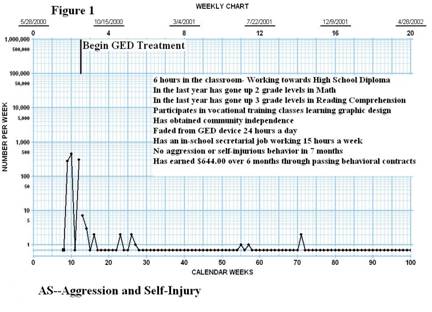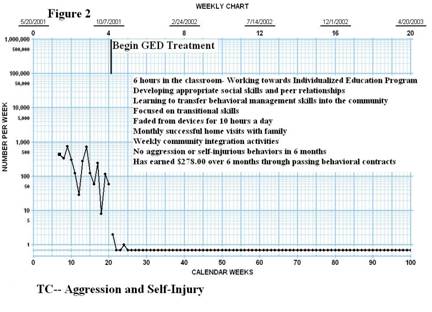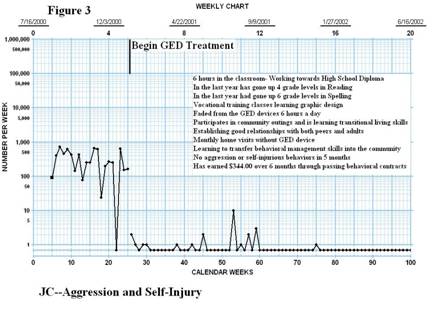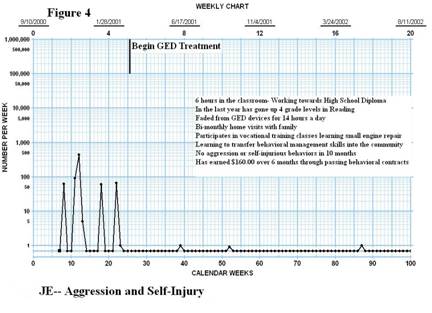



|
Use of Skin-Shock at the Judge Rotenberg Educational Center (JRC) |
Treatment of Severe Aggression and Self-Injury with Contingent Electric Shock
Robert E. von Heyn, Matthew L. Israel, Robert W. Worsham & Melissa Burns
Judge Rotenberg Educational Center
Canton, MA USA
The Judge Rotenberg Educational Center operates day and residential programs for children and adults with behavior problems, including conduct disorders, emotional problems, brain injury or psychosis, autism and developmental disabilities. The basic approach taken at JRC is the use of behavioral psychology and its various technological applications, such as behavioral education, programmed instruction, precision teaching, behavior modification, behavior therapy, behavioral counseling, self-management of behavior and chart-sharing. The behavior modification treatment included court approved use of the Graduated Electronic Decelerator (GED), a contingent skin shock device, to decelerate specific targeted behaviors for some individuals. The present report describes the effectiveness of the GED with four individuals referred to the Judge Rotenberg Educational Center (JRC) for treatment of their intense aggression, self-injury and other disruptive behaviors such as property destruction and noncompliance. These individuals functioned between mild mental retardation and average intelligence and had received various psychiatric diagnoses. These individuals were not typical of those that have been treated with contingent electric shock as reported in the psychological literature. Most published articles have dealt with individuals with more severe cognitive impairments, developmental delays and/or autism. However, a common factor between these individuals and those described in the literature are their intense aggressive and self-injurious behaviors that had not responded to more traditional treatments. For these individuals, medications, positive-only behavior modification and traditional types of psychotherapy had failed to produce a significant impact on their interfering behaviors. In conjunction with the treatment to decelerate these inappropriate behaviors, academic education, daily living skills, social skills and community integration were taught. Information on previous treatments, number of placements, diagnoses and grade level are presented. Frequency data of targeted behaviors were collected hourly and plotted on daily, weekly and monthly charts. Other areas of improvement in these individuals’ living and working environments and development of new skills are also provided.
Method
All participants were initially treated with highly structured behavior plans that used a variety of Differential Reinforcement of Other Behaviors (DRO) contracting. Contract lengths varied between 5 minutes and 24 hours, depending on the frequency of the targeted behaviors. Reinforcers were individualized for each participant and based on their verbal preferences. A token economy, in the form of points or pennies, was also in place for each participant. Tokens were awarded for passing contracts, completing academics or exhibiting other defined prosocial behaviors. Points or pennies could be spent in a variety of ways to purchase preferred items or activities. A response cost system was also in place whereby tokens were deducted when targeted behaviors occurred.
When participants exhibited aggressive or self-injurious behaviors emergency physical or mechanical restraints were employed. Chemical restraint was never used. For more information on JRC’s programs visit www.judgerc.org.
For these individuals, the positive only approach did not produce a clinically significant improvement in their targeted behaviors. These behaviors interfered with their entire educational and habilitative programming and posed a significant risk of injury. Therefore, at various intervals after intake, JRC petitioned the Probate Court in Massachusetts for permission to use the Graduated Electronic Decelerator (GED) to treat their challenging behaviors. The GED is an FDA registered medical device that administers a 2-second skin shock when remotely activated by a therapist. The proposed treatment plan presented to the Court, written by a doctoral level psychologist or clinician, operationally defined the behavior topographies JRC requested for treatment with the GED. When GED treatment began the individual’s daily recording sheet described those topographies for which the clinician prescribed GED treatment. To insure reliable treatment, two therapists confirmed the existence of the targeted behavior on the individual’s daily recording sheet before the GED consequence was administered. Twenty-four hour a day videotaping and live monitoring also insured treatment consistency. For more information on the GED see www.effectivetreatment.org.
Participants
AS
· 19-year-old female admitted to JRC on July 9, 2001.
· Medications included Ritalin, Dextrostat, Risperdal, Paxil, Clonidine, Depakote, Seroquel, Luvox, Adderall and Buspar.
JC
· Medications included Ritalin, Trazadone, Tegretol, Thorazine, Depakote, Cogentin, Topamax, Risperdal and Olanzapine.
· Past treatments included a behavior modification program, 1:1 staffing, individual psychotherapy and physical restraints.
· Diagnoses included: Oppositional Defiant Disorder; Bipolar Disorder; Attention Deficit Hyperactivity Disorder, Combined Type; Dysthymia; Psychotic Disorder, NOS; Cognitive Disorder; Nonverbal Learning Disability; Intermittent Explosive Disorder and Organic Brain Syndrome.
· Targeted behaviors included physical aggression and self-injurious behaviors that encompassed throwing herself down a flight of stairs, assaulting her siblings with scissors, biting herself, cutting her wrists, head-banging and pounding walls.
Results and Discussion
Figures 1 through 4 contain the behavior charts of the combined frequencies of aggression and self-injurious behaviors and some of the positive effects of GED treatment. The data clearly indicate the efficacy of the behavioral treatment package in rapidly decelerating the rate of the targeted behaviors and the continued reduction to zero rates. The behavioral program, rich in positive reinforcers, together with a punishment component to rapidly decelerate inappropriate behaviors, produced no negative side effects and allowed medication and all restraint to be eliminated. As importantly, it allowed these individuals to actively engage in an educational curriculum, live in community-based apartments and, in some cases, become gainfully employed. In all of these cases they jumped two or more academic grade levels in less than a year. In many cases family contact was reestablished, and peer relationships improved. While this method may be considered intrusive, the individuals and their families welcomed this treatment and credit treatment success to it. With further research it may prove that this procedure is the most effective, least intrusive treatment available for individuals such as these who have only worsened under a myriad of medications, psychotherapy and weaker treatment programs.
Table 1
The Effect of GED on Aggressive and Self-Injurious Behaviors
|
Participants |
Pre-GED Rate/week |
Total GED Applications |
Weeks of GED Treatment |
Median GED/week |
Immediate Effect of GED |
|
|
AS |
207 |
6 |
90 |
0 |
¸45 |
|
|
TC |
248 |
7 |
31 |
0 |
¸60 |
|
|
JC |
323 |
28 |
70 |
0 |
¸165 |
|
|
JE |
723 |
6 |
62 |
0 |
¸2 |
|



